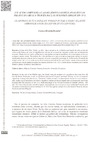Please use this identifier to cite or link to this item:
https://accedacris.ulpgc.es/jspui/handle/10553/114234
| DC Field | Value | Language |
|---|---|---|
| dc.contributor.author | Heredia Heredia, Carmen | en_US |
| dc.date.accessioned | 2022-03-29T08:07:11Z | - |
| dc.date.available | 2022-03-29T08:07:11Z | - |
| dc.date.issued | 2021 | en_US |
| dc.identifier.issn | 2386-6837 | en_US |
| dc.identifier.uri | https://accedacris.ulpgc.es/handle/10553/114234 | - |
| dc.description.abstract | A fines de la Edad Media, las islas, fueron receptoras de población que llegaba de todos puntos de la Península Ibérica, así como de significativas colonias de comerciantes europeos atraídos por su importancia comercial. Dentro de estos nuevos pobladores se encontraban las mujeres castellanas. Son estas mujeres en las que centramos nuestro estudio. Tras analizar los Libros de Datas en el que se extrajo un importante número de mujeres beneficiarias de casas y tierras tras la conquista, así como un pequeño porcentaje de los Protocolos Notariales de Tenerife entre 1505 a 1511 donde se analizó la compra y venta de bienes, continuamos nuestro estudio dentro de los Protocolos con el análisis de dicha documentación entre 1518 -1521 a través de dos escribanos de la isla de Tenerife, Alonso Gutiérrez y Juan Márquez. | en_US |
| dc.description.abstract | At the end of the Middle Ages, the islands were the recipient of a population that came from all over the Iberian Peninsula, as well as significant colonies of European merchants attracted by their commercial importance. Among these new settlers, there were Castilian women. It is these women that we focus our study on. After analyzing the Data Books in which a significant number of women beneficiaries of houses and lands were extracted after the conquest, as well as a small percentage of the Notarial Protocols of Tenerife between 1505 and 1511 where the purchase and sale of goods were analyzed, we continue our study within the Protocols with the analysis of that documentation between 1518 -1521 through two notaries from the island of Tenerife, Alonso Gutiérrez and Juan Márquez. | en_US |
| dc.language | spa | en_US |
| dc.publisher | Cabildo Insular de Gran Canaria | en_US |
| dc.source | XXIV Coloquio de Historia Canario-Americana [ISSN 2386-6837] | en_US |
| dc.subject | 630909 Posición social de la mujer | en_US |
| dc.subject | 550403 Historia medieval | en_US |
| dc.subject.other | Mujeres | en_US |
| dc.subject.other | Canarias | en_US |
| dc.subject.other | Fuentes | en_US |
| dc.subject.other | Protocolos notariales | en_US |
| dc.subject.other | Conquista | en_US |
| dc.subject.other | Women | en_US |
| dc.subject.other | Canary Islands | en_US |
| dc.subject.other | Sources | en_US |
| dc.subject.other | Notarial Protocols | en_US |
| dc.subject.other | Conquest | en_US |
| dc.title | Un acercamiento a las mujeres castellanas en las Islas Canarias a través de las fuentes (siglos XIV-XV) | en_US |
| dc.title.alternative | An approach to castilian women in the Canary Islands through sources (XIVth-XVth century) | en_US |
| dc.type | info:eu-repo/semantics/conferenceobject | en_US |
| dc.type | ConferenceObject | en_US |
| dc.relation.conference | XXIV Coloquio de Historia Canario-Americana | en_US |
| dc.investigacion | Artes y Humanidades | en_US |
| dc.type2 | Actas de congresos | en_US |
| dc.description.numberofpages | 8 | en_US |
| dc.utils.revision | Sí | en_US |
| dc.identifier.ulpgc | Sí | en_US |
| dc.contributor.buulpgc | BU-HUM | en_US |
| item.grantfulltext | open | - |
| item.fulltext | Con texto completo | - |
| crisitem.event.eventsstartdate | 30-11-2020 | - |
| crisitem.event.eventsenddate | 03-12-2020 | - |
| crisitem.author.fullName | Heredia Heredia, Carmen | - |
| Appears in Collections: | Actas de congresos | |
Page view(s)
104
checked on Apr 27, 2024
Download(s)
45
checked on Apr 27, 2024
Google ScholarTM
Check
Share
Export metadata
Items in accedaCRIS are protected by copyright, with all rights reserved, unless otherwise indicated.
